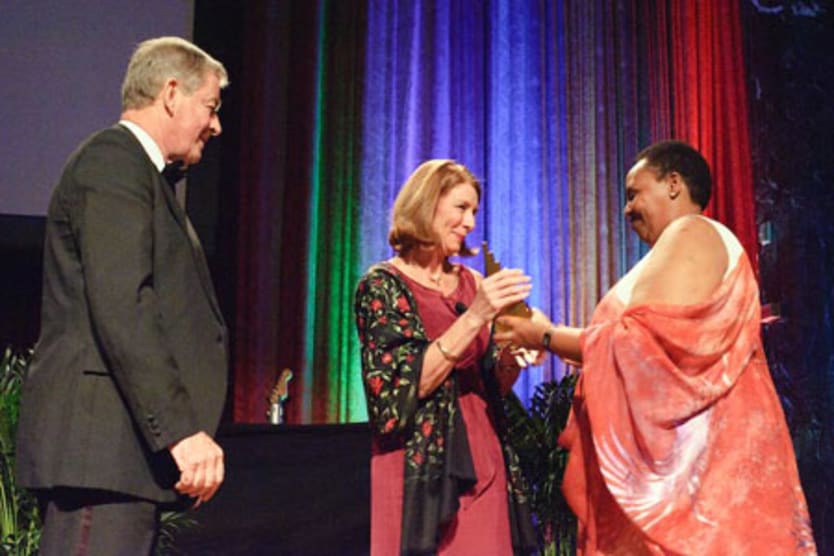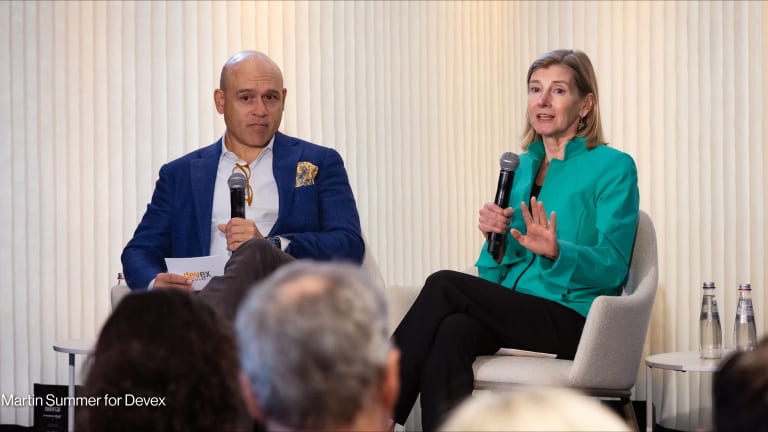
The Hunger Project set out in 1977 with the ambitious goal to end hunger within 20 years. That goal proved unattainable, but the New York City-based nonprofit is soldiering on with a host of innovative projects in South Asia, Africa, and Latin America.
Part of the Hunger Project’s strategy is to organize clusters of villages to manage anti-poverty programs focused on everything from health care to agriculture and banking.
Jill Lester, a former Australian diplomat and senior executive at the Commonwealth Bank, became the Hunger Project’s CEO in 2008. She spoke with Devex about her priorities and goals for the organization as it moves forward during tough economic times. In other parts of the interview, Lester also addressed the Hunger Project’s strategic partnerships and staffing needs.
The Hunger Project doesn’t distribute food aid to hungry people because “food aid is not a sustainable solution to world hunger.” What are some of the ways the organization works to address the root causes of hunger?
We accept that there is always a place for food aid when you are in a crisis situation. But what we are dealing with is chronic hunger. We do believe that with chronic hunger, you need to put in a long-term sustainable solution. We believe the best way to do that is actually to empower the women and men to be involved in that solution, and solve their own issues of hunger and poverty working in conjunction with other parts of the infrastructure.
There are three basic pillars to our methodology. The first one is empowering people to feel that they have the solutions in their own hands. Often, we are working with communities that feel disempowered. They may be feeling marginalized, and they may actually also be somewhat cynical from previous interactions [with the aid community] that they’ve had. So we believe that we need to change their mindset from a feeling that they can’t do anything about their situation to the feeling that they can indeed do something about their situation.
The way we mobilize is sort of summarized in what we call our “Vision Commitment Action” workshop. We use that same VCA wherever we work, whether that is in Africa or India or Bangladesh or Mexico. It’s about people having a vision of what it would be like helping solve their own hunger, committing to achieve that vision, and then coming up with an action plan. So that’s the first aspect, mobilizing people to feel that they have solutions.
The second pillar is women’s empowerment. We put women at the forefront of everything we do, because we believe that there can be no long-term sustainable solution unless women are involved.
The third aspect is what really makes it sustainable. We ensure that people form partnerships with their local authorities, their local governments, so that they can access the services to which they are entitled. It’s not the Hunger Project that provides the teacher or the agricultural extension worker. That comes from the government services also informing that partnership. Partnerships are a two-way street. Not only are people then able to access those services, but they are part of a country’s infrastructure in a way that they weren’t earlier. Their voices are heard and their situation is taken into account when future decisions are made.
The Hunger Project started in 1977. How has the organization’s approach to ending hunger evolved or changed since then?
I haven’t even been here two years, so my observations about this have to be very much based on my research and my understanding. But when it started it was an organization that relied on advocacy and education, but particularly in the developed world, where people raised the issue of a world free from hunger. The organization put a lot of effort into getting people to understand that it could be achieved given the right commitment and right resources were made available. As that acceptance grew - that hunger and abject poverty are something the whole world can help solve - they moved to putting programs in on the ground. So, for about the last 15 years, the programs have been run on the ground. They are prototypes of our methodology. We can demonstrate what we mean about helping people end their own hunger and poverty.
The Hunger Project is involved in a number of gender equality campaigns. Can you share some examples of the organization’s work that illustrate best practices for how aid can be delivered effectively to empower women and reduce hunger?
We work on three continents: Africa, South Asia, and Latin America. In each of those places we have the three pillars I talked about: mobilization, women’s empowerment, and partnerships with government. But in a way that is flexible and adaptable to the situations. I’ll give you an example of one from each of those.
In India, we work with the elected women representatives. A law was passed in India reserving one-third of all local government seats for women. This was a very admirable thing to do, but we’re often talking about women who have no understanding about what local government means. They may be illiterate. Certainly because of the situation, many women find themselves in [a situation where] they have been sort of puppets of the men. We have put in place a whole series of workshops to empower those elected woman representatives to use their power and authority on the local council to make things better for their communities.
We also know from all the workshops we do that people learn a lot from our workshops, but - like people everywhere - they learn the most from their peers. So we’ve also put in place a thing called federations, where we bring together all the elected women representatives in one state. For example, in Rajasthan we have a federation where we bring together all the women we’re training in the various parts of the state, and they learn from each other about how they’ve tackled common issues and problems.
In Africa, I met a woman named Sophie, in Uganda. As you know, women all over Africa have to cook their food over very unhealthy open fires. It’s very bad for their health and their children’s health. It’s bad for the environment, and it uses a lot of fuel. Once her basic hunger had been satisfied, Sophie was able to turn her mind to being more creative, and she came up with a wonderful little clay oven, which burns less fuel, is much better for the environment, and is also much healthier for her and her children.
Another example I might give you is in Malawi, where we have a very path-breaking HIV/AIDS program. We believe that people with HIV/AIDS should also be given microfinance, as they are often denied microfinance. So we extend microfinance to them. We extended one woman a loan, she’s repaid it, and she’s now using the money that she earns from her business to send her brother to university.
We’ve got lots of examples of women who’ve really seized the opportunity with both hands. In Latin America, a lot of the work we do is with indigenous women. In Chiapas, Mexico, we’ve been working with the indigenous women who do wonderful embroidery and weaving. The women said, “We’ve heard about the Web. Why can’t we sell it on the Internet?” We were able to get a computer for them, one of the women, Margarita, took a class, and they are now selling their weaving on the Internet.
What role do you think technological innovations can play in eliminating hunger?
We think the best technological innovations are the ones the people come up with themselves, such as the one I’ve just told you about with Sophie and the stove. We believe that it is not sustainable to import very high-tech, expensive imported technology. We think that it needs to be low-cost, low-maintenance, and relevant to the situation in which we’re working. Having said that, there are things like treated bed nets. There are also female condoms, which we use in our HIV/AIDS work in Malawi. Also, we’re using mobile phones to help connect various communities. There are many examples of simpler, low-cost technology that can be assimilated more easily into their lives.
You became the Hunger Project’s CEO in 2008. What direction would you like to see the organization head in as it moves forward?
We’ve just finished our strategic direction document. I’ve called it a “strategic direction” and not a “strategic plan.” I think it’s really important given the rapidly changing environment in which we’re working to have a broad direction to follow, but not have such an inflexible blueprint that you can’t adjust as you’re moving forward.
We won’t move away from our mission, which is obviously to see the end of hunger and poverty. We’re not planning to move away from our approach, which emphasizes those three pillars, of mobilization, women’s empowerment, and partnership with local government. But the direction I do want to see us going in is to do those things that are required so that we can scale up in a way that we’ll see those elements of our approach - particularly the mobilization, the women’s empowerment, and the need for decentralization of resources to the rural areas - scaled up. We would like to see others incorporate those elements into the way they do development.
We have chosen three broad key priorities to take us forward into the next five years. The first one is impact assessment, and really putting some emphasis on making sure we monitor, measure, and disseminate the impact we’re having on the ground in such a way that people understand how powerful the approach that we’re adopting is. The second thing is partnerships. We don’t want to be everything to everyone. We would welcome the opportunity to work in alliances and groups, because we think that would make the model even stronger and more powerful and more sustainable. And the third thing that I want to do is spread our influence and awareness. We are 32 years old, and I think it’s time that we share our learnings and our approach as widely as possible. So those are the three things: impact assessment, partnerships, and expanding our influence.
What are your top suggestions for U.S. President Barack Obama as he revamps international assistance?
I’ve been incredibly encouraged by the direction that I’ve already seen. Recently, the G-8 made the big announcement on food security. As I read the announcement, there were a lot of other boxes there that I could tick that really resonate with the Hunger Project’s approach. He’s not talking about food security simply by expanding large-scale agriculture - he’s talking about small-scale rural farmers. He wasn’t talking about doing it by means of high-tech - he’s talking about helping people help themselves. And finally, he acknowledged the important role played by women if you’re really going to address the problems of hunger in a way that has a long-term solution. So I’m very heartened by everything I’m seeing.
What impact is the current economic crisis having on the Hunger Project? How is the organization adjusting its programs in light of the economic downturn?
For very good prudent reasons, we assessed the situation last year as we were doing our budget. We didn’t scale down our programs so much as we put on hold expansion plans. What do I mean by putting on hold? Well, instead of building more epicenter buildings this year, I coined a phrase “consolidation for growth.” I think this year is a really important one for us programmatically, by [us] not expanding but making sure that we’re actually going back and comprehensively completing much of the work that we had commenced in a way that really, truly leads to self-sufficient takeoff in those epicenters.
We’re using this time as well in our global offices by making sure that our systems, our policies and our processes are all really scrubbed up and ready for action, and putting in place some of those things that I mentioned as my strategic priorities going forward. So we’ve put a lot of effort this year into the impact assessment, using this slightly quieter time to make sure that we are really developing the tools and the techniques so that we can measure the result that we are achieving.
Is the organization experimenting with any new fundraising initiatives in light of the economic downturn?
We’ve introduced some different ways of doing things. What I’m trying to do is leverage some of the strengths that we’ve perhaps not leveraged quite so strongly. I mentioned before that we have partner countries. One of the great advantages I think the Hunger Project has is that global reach. So we’ve introduced global campaigns so that everybody - whether they are in the Netherlands, Australia, or the U.S. - really feels that they’re working in one team and moving towards a common objective.
Last year we had one of the first of those global campaigns. We called it “Our Best Year Yet,” and really had a huge amount of that strength of the team working together, sharing different ideas and learnings. And we achieved, indeed, that. We actually raised more revenue last year than ever before. And we’re just finishing off what I’ve called our “summer surge.” Traditionally, summer is a very slow period for fundraising. But again, by sharing ideas, keeping the focus, making people really feel that there’s a powerful motivation, we’ve just also achieved a really wonderful push forward in terms of the fundraising. At this stage, we have raised as much as we had raised last year in terms of the percentage of the annual budget. Of course it is a slightly smaller annual budget, but at least the percentage is there.
The other things we’re doing - we’re having a lot of events. U.S. fundraisers have called the second quarter their “event quarter,” and they’ve arranged 50 or 60 events for our “investors,” the people who support us. They’ve arranged a lot of events in investors’ homes, bringing an awareness of the Hunger Project to people who perhaps hadn’t heard of it before. Perhaps this is not the year in which they want to begin to make investments, but as things pick up, as the economy becomes more certain, we believe that these foundations we’re laying this year will really start to pay off.








